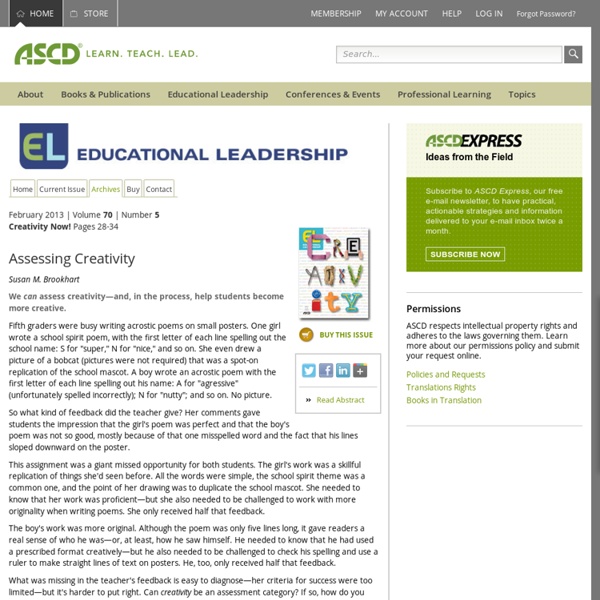Zoom
Trash
Related:



On assessing for creativity: yes you can, and yes you should I tweeted yesterday an interesting news item in Erik Robelen’s blog in Education Week that a few states (Oklahoma, California, Massachusetts) are seriously looking into some sort of assessment of creative thinking as part of the whole 21st century skills/entrepreneurship movement. I think it is a great idea, with a lot of potential for leveraging change. Now, of course, the naysayers are quick to say that you cannot measure creative thinking. This is silly: here is a rubric for doing so: Creative. We can and do measure anything: critical and creative thinking, wine quality, doctors, meals, athletic potential, etc. (A plug, once again for You Can Measure Anything.) In Bloom’s Taxonomy – designed to categorize and guide the design of measures – Synthesis was the level of thinking for such creativity, as Bloom makes clear in defining it: Synthesis is here defined as the putting together of elements and parts so as to form a whole. Ditto and underscored for student oral presentations.
Engineering Groups Engineering in the Middle School Classroom! IDEAS is the result of a project funded by The Engineering Foundation and organized by two of the worlds major engineering societies, the American Society of Mechanical Engineers (ASME) and the American Society of Civil Engineers (ASCE). Our goal when soliciting project activities was to identify low-cost, "hands-on" engineering projects for use in middle schools math, science and technology classes. The announcement attracted over 60 entries from teachers, engineers, and concerned educational and professional groups. Each project concept has three levels of activity – exploratory, intermediate, and advanced. "IDEAS" is not an isolated effort. In 1998 ASME published "Engineers Solve Problems," a collection of seven hands-on experimental problems developed in cooperation with the Salt Lake City school system, with the support of the National Science Foundation. ASME continues to help students when they reach the high-school level.
Assessment FOR Creativity: What Would It Look Like? | creativiteach Assessment is front and center in just about every educational venue today. Whatever we want to develop in schools, we need to think about how it relates to assessment. To me, one of the most important concepts in assessment is Stiggins’ differentiation of assessment OF learning and assessment FOR learning. Assessment OF learning, of course, is assessment mainly focused on evaluation, letting us know how much students have learned. I have said before that the distinction Stiggins made has caused me to contemplate a parallel relationship between assessment and creativity. Assessment FOR creativity considers how we can assess the content we teach in ways that are supportive of creativity. Assessment FOR creativity builds intrinsic motivation through a sense of increasing competence. Over the next few weeks I’ll think about these three characteristics and how they might play out in classrooms. Like this: Like Loading...
Teachers Manuel to A Paperless Classroom So how about having a paperless classroom ? Some say this is over-hyped at best, an outright fad at worse. Well let's get down to it and see what it all takes to do it. 1- Have a Classroom Blog /Websites/Wiki/Portal We can not talk about going paperless without first setting up a virtual space for our class. 3- Use web tools to increase productivity Here are some examples : Use and encourage your students to use presentations using these tools such as : Google Presentations, Prezi, or this collection of other presentation making toolsUse and get students to use visualizations and infographics to represent key concepts and demonstrate their learning. 4- Grading online Gone are the days when teachers would rely only on traditional gradebooks to record both their teaching progress and their students achievements.
Reframing Failure as Iteration Allows Students to Thrive Boy: A Rube Goldberg machine is complicated for a simple task. Girl: Boss Level is a week where we work with our home base to complete a project by the end of the week. And we also don't have homework or any other of our usual classes. Teacher: You walk into a Boss Level classroom, you're not seeing really a classroom. Boy: We could do something like this, if we had a hole. Boy: How about this one? Girl: They're tiny. Boy: No, we already have a marble. Girl: I know. Boy: Yeah, I fixed them here. Boy: Wait, wait, wait, wait. Teacher: My favorite part about Boss Level is the actual building phase. Girl: Failure is really bad, but I guess if you have a good attitude, then you can always make it what you wanted it to be and not to get frustrated. Boy: Failure reframed as iteration means when you fail, just try again. Kids: Yeeeahhh!!! What?! Teacher: Students really take a lot of ownership for the machines that they create. Girl: Home base is...
30 Things You Can Do To Promote Creativity in Your Classroom - InformED Mimi Ito on Learning in Social Media Spaces (Big Thinkers Series) Mimi: So my question is this, why do we assume that kids' socializing and play is not a side of learning? And on the flip side, why do we assume that schools can't have a spirit of entertainment and play as part of what they're doing? Mimi: Last year I wrapped up a three-year study with a large team of researchers where we were looking at a lot of different examples of kids' new-media practice, ranging from sort of everyday hanging-out behavior on sites like Myspace and Facebook with text messaging, IM to what we were calling more "geeked-out" kinds of participation, like making YouTube videos, remixing videos, creating podcasts, engaging in fan fiction, and other forms of fan production. Mimi: I think our most important top-level finding was that there was tremendous diversity in what kids were doing online and what kids were learning online. Mimi: There really is a gap in perception and understanding between generations about the value of engagement with online activities.